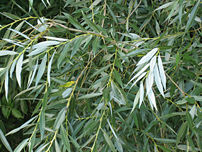[amazon_link asins=’B00CEMLXP8,B006R12ZN6,B007FFVYR6,B00PT77066,B00EI6HQF4,B000UAPD0W’ template=’ProductCarousel’ store=’finmeacur-20′ marketplace=’US’ link_id=’359fdb6f-f5a0-11e6-999f-21eb225d97d3′]
Botanical Name : Salix eleagnos
Family: Salicaceae
Tribe: Saliceae
Genus: Salix
Species:Salix eleagnos
Kingdom: Plantae
Order: Malpighiales
Synonyms: Salix rosmarinifolia, Rosemary Willow
Common Names: Olive willow, Hoary willow, Rosemary willow
Habitat: Salix eleagnos is native to central and southern Europe and south west Asia.
Description:
Salix eleagnos is an erect bushy deciduous shrub with narrow grey-green leaves up to 20 cm (8 in) long, which turn yellow in autumn (fall). The plant is 3 m (10 ft) tall by 5 m (16 ft) broad.The green catkins, 3–6 cm (1–2 in) long, appear with the leaves in spring, male catkins having yellow anthers.
Like all willows, the species is dioecious. The specific epithet eleagnos is frequently spelt elaeagnos, though the original spelling has been accepted as a correct Greek form.
S. eleagnos subsp. angustifolia has gained the Royal Horticultural Society‘s Award of Garden Merit.
Botanical details:
*Growth form: the plant is a shrub (a woody plant with several stems growing from the base) the plant is a tree
*Leaf type: the leaf blade is simple (lobed or unlobed but not separated into leaflets)
*Leaves per node: there is one leaf per node along the stem
*Leaf blade edges: the edge of the leaf blade has no teeth or lobes / the edge of the leaf blade has teeth
*Leaf duration: the leaves drop off in winter (or they wither but persist on the plant)
*Armature on plant: the plant does not have spines, prickles, or thorns
*Leaf blade length: 5–160 mm
*Leaf blade width: 1–8 mm
*Leaf stalk: the leaves have leaf stalks
*Fruit type (general): the fruit is dry and splits open when ripe
*Bark texture: the bark of an adult plant is thin and smooth
*Twig winter color: brown,red,yellow
*Bud scale number: there is one scale on the winter bud, and it covers the scale like a cap
Medicinal Uses:
In Ancient Greece, the bark of the white willow (Salix alba) was chewed to relieve the pain of gout and to reduce fever. In the fifth century B.C., Hippocrates, the father of modern medicine, prescribed ground willow bark to ease aches and pains. In the 1st century A.D. Dioscorides, a Greek physician in service to the Romans, wrote that the ingested bark and leaves of Salix alba reduce fever and relieve pain. For centuries, Europeans used tea made of the roots and leaves to lower fever and relieve aches. The Chickasaw Indians used tea made from the roots to relieve headache.
In 1830, German researchers isolated salicin from the bark of the white willow tree and from other plants. Their research determined that ingested salicin becomes salicylic acid in the stomach, and that salicylic acid is responsible for the desired effects as well as undesirable toxic side effects that include gastrointestinal bleeding. In 1875 a derivative, acetylsalicylic acid, was synthesized from salicylic acid. Acetylsalicylic acid was discovered to have the properties of and to have many fewer side effects than salicylic acid. In 1899 acetylsalicylic acid appeared in powder form for the first time; 1915 was the first time that it appeared in pill form. A part of the terms of the peace treaty with Germany following World War I was the surrender of the patent and of the trade mark ASPIRIN for acetylsalicylic acid. Since then acetylsalicylic acid (abbreviated as ASA) has been universally known as aspirin. Aspirin is one of the most important and one of the cheapest drugs in the medical armamentarium for the treatment of human diseases, for the relief of pain, and as a blood thinner in the prevention of heart attacks and strokes caused by disease in the blood vessel walls.
Disclaimer : The information presented herein is intended for educational purposes only. Individual results may vary, and before using any supplement, it is always advisable to consult with your own health care provider.
Resources:
https://en.wikipedia.org/wiki/Salix_eleagnos
https://gobotany.newenglandwild.org/species/salix/elaeagnos/
http://www.piam.com/mms_garden/plants.html





























